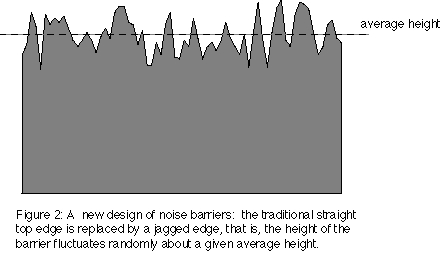Acoustical Society of America
ICA/ASA '98 Lay Language Papers
Jagged-edge Noise Barriers
Penelope Menounou- menounou@mail.utexas.edu
Ilene J. Busch-Vishniac
David T. Blackstock
Department of Mechanical Engineering
The University of Texas at Austin
Austin, TX 78759
Popular version of paper 1aNSb2
Presented Monday morning, June 22,1998
ICA/ASA '98, Seattle, WA
Noise pollution affects everyday life in our homes, schools, and work places by interfering with speech, sleep, and concentration. Over a period of years noise can induce hearing loss; indeed over 10 million Americans owe their hearing impairment to noise exposure. Noise is also a major cause of annoyance. Road traffic noise is by far the leading irritant.
Few options are available for controlling traffic noise. Vehicles can be modified to produce less noise, zoning restrictions can prevent residential construction near major roads, or traffic noise barriers can be constructed between major roadways and communities. Traffic noise barriers have proved to be the method of choice throughout the world.
Traffic noise barriers are usually concrete walls 3-5 m high built along the highways. The barriers block the direct path from the noise source (traffic) to nearby communities. A {\it shadow zone} is created behind the barrier, in which listeners are protected from the noise (see Fig. 1). However, sound can still reach into the shadow zone by a variety of physical mechanisms. One of the most important mechanisms is called diffraction: Sound travels from roadway vehicles to the top edge of the barrier. There the edge scatters, i.e., diffracts, the sound in all directions. Some of the scattered sound reaches listeners behind the barrier. It is as though the sound arriving at the edge energizes it to be a new source of sound.

The high cost of noise barriers -- typical highway noise barriers cost $1,000,000 to $2,000,000 per linear mile -- has motivated research to improve the shielding performance of barriers without substantially increasing their cost. Our research group at the University of Texas at Austin has developed a new design of noise barrier. In the new design, the traditional straight top edge is replaced by a jagged edge, that is, the height of the barrier fluctuates randomly about a given average height (see Fig.2). By replacing the straight top edge by a jagged one, we expected to reduce the coherence of the scattered sound so that sound scattered from neighboring edge pieces would not reinforce one another. We reasoned that the result would be an improvement in barrier performance.

As a first step, our research group conducted indoor laboratory experiments with scale models. The results, which have been reported at previous Acoustical Society meetings, indicate that making the top edge of the barrier jagged can improve performance by up to 6 dB. This is a significant improvement and has stimulated further research.
In the present paper a theoretical model is presented that allows us to understand quantitatively the effect of the jagged top edge and to predict its performance. In our model, called the Directive Line Source Model (DLSM), the sound at a receiver behind the barrier is considered to be emanating from a set of point sound sources distributed along the jagged top edge. DLSM gives predictions that agree well with the experimental data. Further, because the model is easy to apply, it is a promising and powerful tool for further research on irregular-edge barriers, including curved edges.
The ultimate goal of the research is to specify the shape of an edge profile that has "optimum" shielding performance. By using DLSM to find the optimum design, we avoid costly and time consuming experiments with different edges. Once the optimum edges are identified, model experiments can be done to test the predictions. Finally, full scale experiments can be done outdoors to test the designs against real traffic noise and realistic weather conditions.
In summary the work reported in the present paper is a first step in understanding and developing a promising new design for traffic noise barriers.